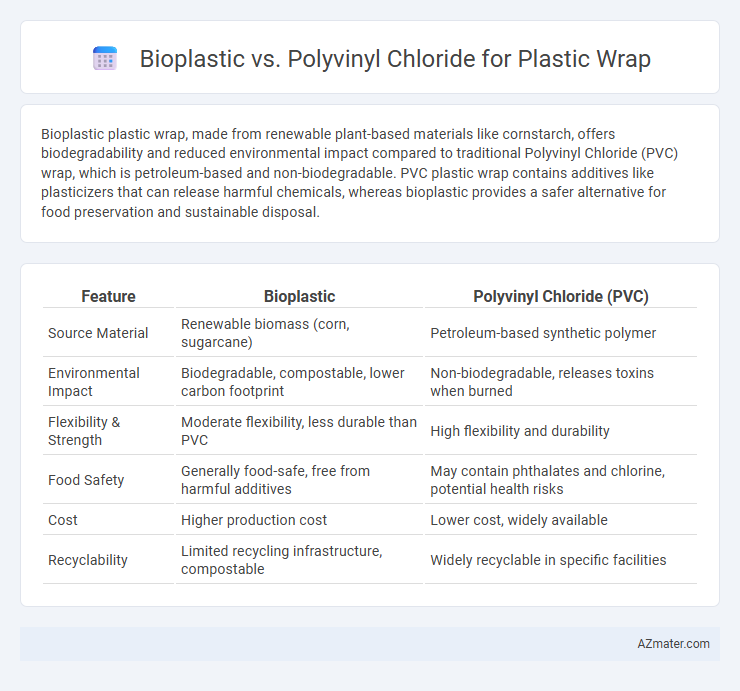Bioplastic plastic wrap, made from renewable plant-based materials like cornstarch, offers biodegradability and reduced environmental impact compared to traditional Polyvinyl Chloride (PVC) wrap, which is petroleum-based and non-biodegradable. PVC plastic wrap contains additives like plasticizers that can release harmful chemicals, whereas bioplastic provides a safer alternative for food preservation and sustainable disposal.
Table of Comparison
| Feature | Bioplastic | Polyvinyl Chloride (PVC) |
|---|---|---|
| Source Material | Renewable biomass (corn, sugarcane) | Petroleum-based synthetic polymer |
| Environmental Impact | Biodegradable, compostable, lower carbon footprint | Non-biodegradable, releases toxins when burned |
| Flexibility & Strength | Moderate flexibility, less durable than PVC | High flexibility and durability |
| Food Safety | Generally food-safe, free from harmful additives | May contain phthalates and chlorine, potential health risks |
| Cost | Higher production cost | Lower cost, widely available |
| Recyclability | Limited recycling infrastructure, compostable | Widely recyclable in specific facilities |
Introduction to Bioplastic and Polyvinyl Chloride
Bioplastics are derived from renewable biomass sources such as corn starch, sugarcane, or cellulose, offering biodegradability and reduced carbon footprint compared to conventional plastics. Polyvinyl chloride (PVC) is a synthetic plastic polymer made from vinyl chloride monomers, known for its durability, flexibility, and excellent barrier properties but associated with environmental concerns and potential health risks. Both materials serve as common choices for plastic wrap applications, balancing factors of sustainability, performance, and safety.
Composition and Manufacturing Processes
Bioplastic plastic wraps are primarily composed of renewable raw materials such as cornstarch, cellulose, or polylactic acid (PLA), which undergo fermentation and polymerization processes to create biodegradable films. In contrast, polyvinyl chloride (PVC) wraps are synthesized from vinyl chloride monomers through polymerization, involving petrochemical feedstocks and often requiring additives like plasticizers to enhance flexibility. Manufacturing bioplastics emphasize eco-friendly processing with lower carbon emissions, whereas PVC production relies on energy-intensive methods with potential release of harmful chemicals during polymerization and disposal.
Environmental Impact: Biodegradability and Pollution
Bioplastic plastic wrap offers significant advantages in environmental impact due to its biodegradability, breaking down naturally within months under composting conditions and reducing plastic pollution in oceans and landfills. Polyvinyl chloride (PVC) plastic wrap, composed of synthetic polymers, resists degradation and contributes to long-term environmental pollution through microplastic formation and toxic chemical release during production and disposal. The use of bioplastics in plastic wrap reduces carbon footprint and minimizes ecological harm compared to persistent PVC waste, highlighting the importance of material choice in sustainable packaging solutions.
Food Safety and Chemical Leaching
Bioplastic plastic wrap, derived from renewable plant-based materials like cornstarch or sugarcane, offers enhanced food safety by reducing the risk of harmful chemical leaching compared to Polyvinyl Chloride (PVC) plastic wrap, which contains additives such as plasticizers that can migrate into food. Studies indicate that PVC wrap can release phthalates and chlorine compounds, posing potential health risks when in contact with fatty or acidic foods. Bioplastics provide a safer alternative by minimizing toxic exposure, making them preferable for preserving food quality and consumer health.
Cost Comparison and Market Availability
Bioplastic plastic wrap generally costs 20-30% more than polyvinyl chloride (PVC) wrap due to raw material expenses and lower production scales. PVC plastic wrap dominates the market with over 70% share, benefiting from established supply chains and widespread availability. Bioplastics, while growing in niche markets, remain less accessible in retail and bulk purchasing sectors due to limited manufacturing capacity.
Performance: Durability and Flexibility
Bioplastic plastic wrap demonstrates moderate durability with enhanced flexibility, making it suitable for light to medium packaging tasks, while polyvinyl chloride (PVC) offers superior durability and tensile strength, ensuring longer-lasting protection. PVC plastic wrap resists punctures and tears more effectively, maintaining a secure seal under stress, whereas bioplastic may degrade faster and exhibit lower resistance to impacts and temperature variations. The flexibility of bioplastic materials supports better conformability on irregular surfaces, but PVC's balanced elasticity and toughness make it the preferred choice for industrial-grade wrap applications.
Consumer Perception and Preferences
Consumer perception of bioplastic versus polyvinyl chloride (PVC) for plastic wrap reveals a strong preference for bioplastic due to its environmental benefits and biodegradability. Studies indicate that eco-conscious consumers prioritize sustainability and are willing to pay a premium for bioplastic wraps, associating them with reduced plastic pollution and safer food packaging. PVC, despite its durability and cost-effectiveness, faces criticism for its potential health risks and environmental impact, influencing consumer preference towards more sustainable alternatives.
Regulatory Standards and Compliance
Bioplastic for plastic wrap complies with emerging environmental regulations emphasizing biodegradability and reduced carbon footprint, aligning with standards set by the European Bioplastics and ASTM International. Polyvinyl chloride (PVC) is regulated under strict guidelines such as REACH in Europe and the U.S. EPA's TSCA, requiring careful management due to its potential release of harmful additives and chlorine-based compounds. Compliance for PVC often involves meeting stringent limits on phthalates and dioxins, while bioplastics are increasingly favored to meet global sustainability mandates and reduce plastic pollution.
Future Trends in Plastic Wrap Materials
The future trends in plastic wrap materials reveal a growing shift towards biodegradable bioplastics due to increasing environmental regulations and consumer demand for sustainable packaging. Innovations in bioplastic formulations are enhancing properties like flexibility, barrier performance, and compostability, making them competitive alternatives to traditional polyvinyl chloride (PVC) wraps. Advances in polymer science and recycling technologies are expected to reduce reliance on PVC, which poses concerns related to chlorine content and non-biodegradability, positioning bioplastics as a key solution in eco-friendly packaging.
Conclusion: Choosing the Right Plastic Wrap
Bioplastic plastic wrap offers a renewable, biodegradable alternative to Polyvinyl Chloride (PVC), which is derived from fossil fuels and contains harmful additives like phthalates and chlorine. While PVC provides superior strength and flexibility for long-term storage, bioplastics excel in eco-friendly disposal and reducing environmental impact. Selecting the right plastic wrap depends on prioritizing either durability and performance with PVC or sustainability and compostability with bioplastic options.

Infographic: Bioplastic vs Polyvinyl Chloride for Plastic Wrap
 azmater.com
azmater.com